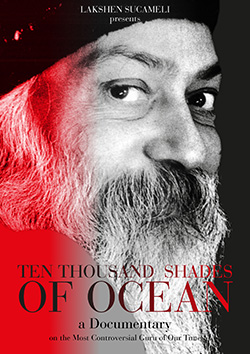Ten Thousand Shades of Ocean

Last week has seen two private screenings of Lakshen’s fresh-off-the-press documentary here in Corfu. A few notes and impressions by Punya (and friends).
We watched the first part, that covers Osho’s life from his birth to his grandfather’s death; school years, university years, his travels across India to give talks to large audiences; initiating his first orange sannyasins, the creation of his chaotic/dynamic meditation, his time at Woodland in Mumbai, the move to Pune in 1974 – the influx of Western seekers, the introduction of therapy as a step to meditation, the discourses in Buddha Hall, the knife attack, the energy darshans in Chuang Tzu, Laxmi’s search for a new commune – and Osho’s sudden departure to the USA.
The second part of the documentary is a work in process. It will cover the time at the castle in New Jersey, the foundation of Rajneeshpuram, the struggle with local politics, Osho’s World Tour and the struggle with global politics, the talks in Mumbai before settling in Pune. It also includes snippets from sannyas life today, showing how the movement is still alive and attracting new people through the meditations Osho has created, his wisdom and vision of life.
During these last few years, Lakshen travelled across Europe and India to interview ‘key’ personalities, asking them questions about their life with Osho. Among them are well-known names like Sheela, Shunyo, Radha, Rashid, Keerti, Ageh Bharti, Turiya, Dharm Jyoti – and less familiar names like Laheru, Ganga (the guide at Khajuraho), Osho’s younger brother Niklank, and the screenwriter Kamlesh Pandey.
Lakshen also interviewed sannyasins who have distanced themselves from the sannyas movement, giving them space to explain the reasons why they did so, e.g. Michael Barnett and Hugh Milne.
The documentary is composed of intercalations of short sections from archive footage of events around Osho, discourse and darshan videos, photos, Yatri’s comics, snippets of the interviews Lakshen filmed on his own world tour – while historical footage, and new footage taken on location in India by his crew – are underscoring the spoken word – sometimes with brilliantly accurate timing. The audio track starts with the voice of the narrator who comes in from time to time to bridge events; then there are the voices of the interviewees, of Osho talking in discourse, and a music track chosen among Madhuro, Narayani and Subodha’s heartful songs, as well as Manish Vyas’s traditional Indian ones; a kirtan by Anadi and music from Joshua, Shastro, Ramadhan, Shantam Arjun.
This first part lasted over one and a half hours. I was glued to the screen from beginning to finish, although I was familiar with most events. It was beautiful to see contemporary footage of places Osho had talked about, the spot on the bank and the bridge from where he used to jump into the river. Anand Divya, the daughter of Osho’s childhood friend Sukraj, telling the story of how Osho threw away the flute after his best friend had drowned. The short snippets of the house he grew up in, the school and colleges he was allowed to attend under the condition he did not attend classes – only the exams! We found ourselves in Khajuraho, guided by Ganga, silently looking at the reliefs of the temple walls.
Sitting on the edge of my seat, intent of not letting any detail get past me, I enjoyed in particular one piece of footage: an evening Sufi Dance in Buddha Hall. Those joyous faces, twirling orange-red robes, the celebration in the air… just to mention one of the jewels I found.
Lakshen’s documentary comes across like a mosaic of tiny half-inch square multi-coloured tiles shining in a spotlight. As so often happens with Osho’s words, we hear a quote – we know we have heard him say that so very often before – but – while watching the film, suddenly something sinks in: surrender, ego, finding oneself.
Another subject discussed and commented upon is sex (of course).
When the credits rolled I realised my face had taken on the expression of WOW: eyes wide open, O-shaped mouth. What a great job Lakshen did! shouted my mind – Well done! After he had freed himself from the many huggers after the showing, I said to Lakshen: It’s rolling – with the hands gesturing (we are Italians after all!) a quick little stream elegantly jumping from pebble to pebble, kept within its banks by the various comments and interviews.
Someone who had seen the film in the first screening mentioned to me that they had felt thrown about by the quick succession of images, the many people interviewed. It did not have this effect on me, I felt the cuts were very delicate and poetic in places; there was a clear thread: Osho’s presence. Driving down home I felt his soft presence very clearly, very soothing. With me.
As this documentary (what we have seen is still in advanced draft form) is meant to be seen by the general public, in a kind of ‘rebuttal’ to the docu-series Wild Wild Country that came out two years ago on Netflix, I have also asked a few friends who were there the other night, people who did not know much about Osho or at least not about those early years, to give their comments:
“It is really a good film, it shows very well who Osho was, his background, his liberation, his lightness, his love for his people, his magnetism, his divine intelligence, his generosity, and the way he guided and helped his people. And I was touched to see the deep respect and love of those close to him already in the early days; his school friends, university professors and colleagues. Of all the films about Osho, it’s my favorite!” S.
“Crazy man!” F.
“I think there are a bit too many interviews from too many people; I would have rather liked to see and hear a bit more of Osho himself. I do like the controversy and also the criticisms as this is a good journalistic approach to show both sides.” A.
“I feel that I did get some new information, learned some things I didn’t know, but also I cannot really capture Osho himself or his main message. But I suppose this is maybe anyway difficult – to try to capture an enlightened being.” N. M.
“I thought the film was exciting, and historically I could follow it very well. But, in a film about Osho I wouldn’t have taken interviews from people who are expressing their resistance.” B.
I am now anxiously waiting for the second part, and also curious to see what Lakshen will make out of the footage he has already had in his kitty for many years. There will certainly be the same interviewees who will take the story further and continue the thread. I see that it would be best to offer both pieces to the public in one go, if Lakshen gets the funding together quickly. It will only be a 3-hour+ bingewatch. I would be in for it!
If you wish to sponsor the second part you can contact Lakshen and write to him on [email protected]
Punya
Punya is the founder of Osho News, author of many interviews and of her memoir On the Edge.
- Log in to post comments
- 248 views
